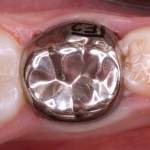
Preformed metal crowns have been used to restore primary molar teeth since the 1950s. The conventional approach involved local anaesthesia, complete caries removal, tooth preparation followed by fitting and cementation of the crown. The Hall technique introduced in 2006 involves the cementing the crown over the carious primary molar using only digital pressure by the dentist or the child’s occlusal force, and without any local anaesthesia or caries removal. Studies have shown the Hall technique to be superior to direct restorations with similar clinical outcomes to the conventional approach.
The aim of this review was to compare the outcomes of preformed metal crowns placed on primary molars using conventional and Hall techniques.
Methods
A review protocol was registered in PROSPERO. Searches were conducted in the Cochrane Central Register of Controlled Trials. Embase, PubMed, Scopus and the Web of Science databases as well as OpenGrey and Google Scholar. Clinical studies with a control group in children aged 2- 12 yrs requiring a preformed metal crown (PMC) but with no periapical or pulpal pathology and published in English were considered. Two reviewers independently screened and selected studies extracted data and assess study quality using the National Institutes of Health Quality Assessment tool. Only randomised controlled trials were included for the quantitative synthesis. The primary outcomes were overall survival at 12 and 24 months.
Results
- 5 studies (4 RCTs, 1 retrospective cohort) were included.
- One RCT was considered to be of good quality 3 of fair quality.
- The cohort study was considered to be of fair quality.
- No significant differences were found between HT and CT for overall success or survival rates (see table).
| Hall Technique | Conventional technique | |
| Overall success 12-months | 88.6% to 100% | 91.3% to 100% |
| Overall success 24- months | 86.3% to 88.1% | 85.2% to 86.5% |
| Survival rate 12-months | 96.9% to 100% | 95.7% to 100% |
| Survival rate 24-months | 91.7% to 95.9% | 91.4% to 92.6% |
- Secondary outcomes discussed included, occlusal changes, behaviour and cooperation of the child, self-reported discomfort and safety, parental satisfaction, treatment duration and cost effectiveness.
Conclusions
The authors concluded: –
…..PMCs placed using either the HT or CT confers similar overall success and survival rates. The HT also requires a shorter treatment time, is more cost-effective and has a high level of acceptability among parents compared to the CT. Given the favourable out- comes, greater consideration may be given towards using the HT as part of standard treatment procedures in carious primary molars in children. Future studies assessing long-term outcomes, clinician’s acceptability, cost-effectiveness, effect on OHRQoL, occlusion and permanent successors, using standardised outcome criteria, are recommended.
Comments
The reviewers registered a review protocol with PROSPERO and searched a good range of databases. However, as they highlighted restricting the review to English language papers may have excluded some relevant studies. Since its introduction in 2006 a number of studies have demonstrated favourable outcomes using the Hall technique with the recent Cochrane review (Dental Elf – 21st Jul 2021) finding that the Hall technique had fewer failures than conventional treatments for primary molars. This new review included 4 RCTs and finds no significant differences between conventional and Hall techniques in terms of survival and overall success rates at 12 and 24 months. A number of secondary outcomes were discussed although variation in the way in which the various studies asses these makes interpretation more difficult, and the authors have proposed a number of outcome success criteria. The use of common outcome sets in future studies would be helpful.
Links
Primary Paper
Chua DR, Tan BL, Nazzal H, Srinivasan N, Duggal MS, Tong HJ. Outcomes of preformed metal crowns placed with the conventional and Hall techniques: A systematic review and meta-analysis. Int J Paediatr Dent. 2022 Sep 24. doi: 10.1111/ipd.13029. Epub ahead of print. PMID: 36151937.
Other references
Dental Elf – 21st Jul 2021
Dental Elf – Hall Technique Blogs
